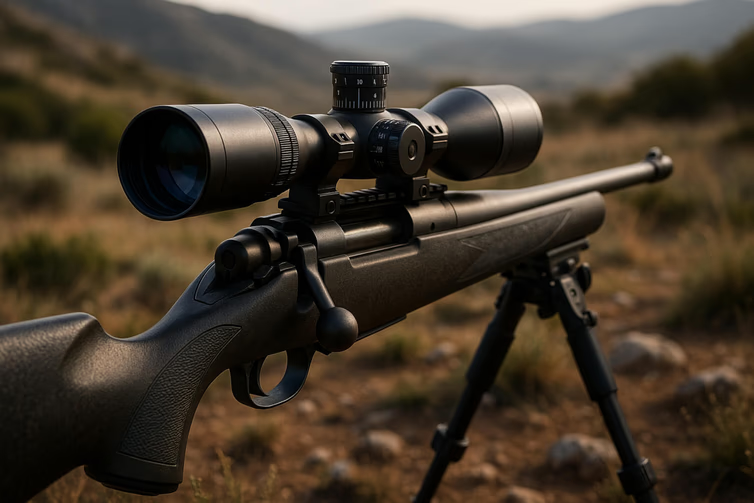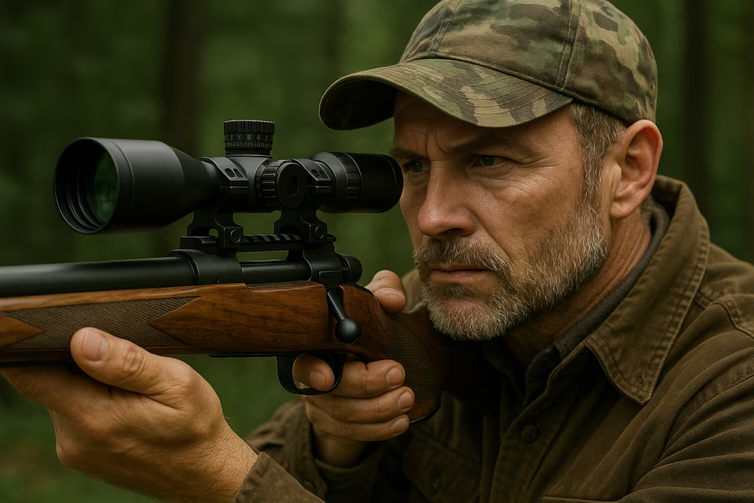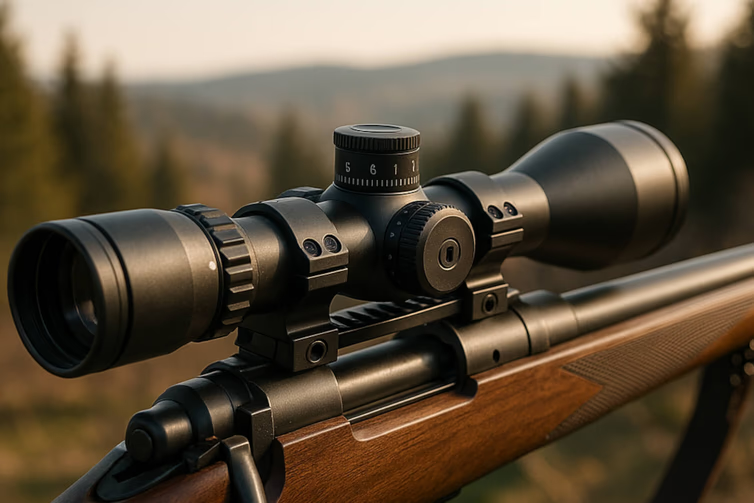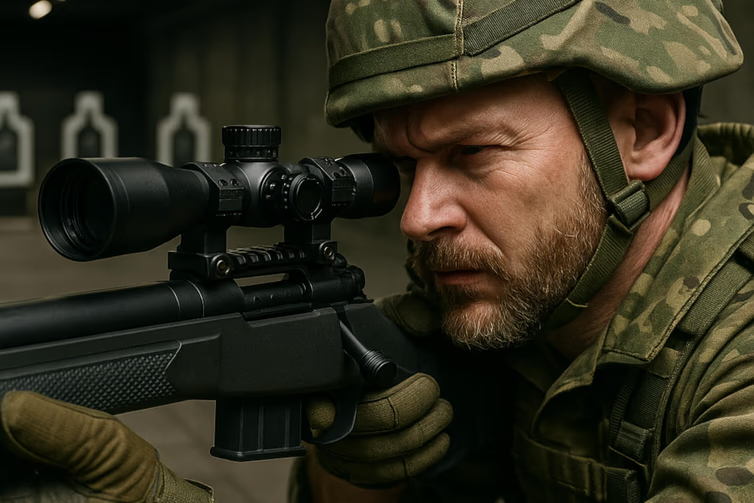How to choose an optical sight

An optical sight is designed to be installed on various types of firearms. A tactical rifle or hunting carbine without optics will have a limited range, which means that it is almost impossible to effectively hit a target at a distance of more than 100 meters.
From this article you will learn what an optical sight is for, how it is constructed, and what parameters to use when choosing one.
What is an optical sight for
The main purpose of an optical sight is to increase the accuracy of aiming a weapon at a target. With its help, the target image can be magnified several times, which is essential when shooting at medium and long distances.
In addition, the sight provides a clear image of the reticle and the target, facilitating the aiming process. Many models are distinguished by the ability to compensate for parallax, that is, they eliminate the apparent displacement of the target when the shooter's eye position changes.
An additional function of optical sights is to observe the surrounding area and search for targets, which is especially important when hunting. Experienced shooters, using the reticle, can determine the distance to the target.
An optical sight is used in hunting, and in sports competitions, and as part of tactical tasks.
How does an optical sight work
To understand how an optical sight works, you should understand its design. The main parts of weapon optics are:
- lens
- reversing lenses
- reticle
- eyepiece
- ballistic correction mechanism
- reticle illumination
- body
The operating principle of an optical sight is easiest to understand using the example of Kepler's astronomical telescope. Its optical part is equipped with two collecting lenses. The lenses are attached so that their optical axes lie on the same straight line, and the focal planes coincide.
The front lens is the objective and has a long focal length. The rear - short-focus - lens faces the eye and functions as an eyepiece, then there is, a magnifying glass. In this case, the objective lens brings the inverted image of the target closer to the observer by a certain number of times. And the eyepiece gives a virtual, enlarged and direct image.
To obtain a direct image, the optics provides a so-called inverting system consisting of 1-2 collecting lenses. The lenses invert the image transmitted by the objective lens. In essence, a modern optical sight is the same telescope, but of a more complex design. For precise aiming, a frame with sighting threads is placed on one of the focal planes or in the plane of the eyepiece. In this case, the shooter sees both the enlarged image of the target and the sighting threads equally clearly. The intersection point of the sighting threads with the optical center of the sight sets the position of the tube axis
Main characteristics of the optical system
The main characteristics of the optical system of the sight include:
- Magnification step. Any optics has magnification parameters - constant or variable. Variable magnification is from x1 to x24 and has a magnification step. Often, one manufacturer produces a series of sights with common features, and one of them is magnification.
- Exit pupil diameter. This parameter shows the diameter of the light beam that passes through the sight and hits the shooter's eye. Since the diameter of the human pupil changes depending on the illumination, it is important that the diameter of the exit pupil of the sight is larger to ensure a full view.
- Exit pupil distance. The characteristic shows the optimal distance of the sight from the shooter's eye or the focus of the light rays transmitting the image from the sight. If this parameter is incorrect, then the shooter's perception of the target will be incorrect and fuzzy.
- Focal plane. The aiming reticle is located in this plane. Depending on the plane in which the reticle is located - the first (control unit) or the second (eyepiece) - its ballistic parameters will change and be preserved or not when changing the magnification.
- Field of view (linear/angular). This is the space that is visible through the sight. Measurements are taken at a distance of 100 meters from the lens. The higher this parameter, the better the image. The angular field of view is nothing more than the angle at which light enters the lens.
- Light intensity. This characteristic is especially important when hunting at dusk and from towers. Using high-aperture optics allows you to avoid distorting the picture, not losing contrast and clarity.
- Click to enter corrections. This is the step by which the center of the crosshair is shifted relative to the previous position at a distance of 100 meters from the lens. The smaller the step, the more accurately the optical sight is adjusted.
- Angular minute MOA. This is a unit of measurement of degrees in a circle, a minute is 1/60 of a degree.
- Aiming reticle. Performs the function of aiming at the target.

Types of aiming reticles
There are several types of aiming reticles, depending on the task.
A driven reticle is a reticle that does not have divisions or crosshairs, which is used to quickly fix running targets. Reticles of the 'duplex' or 'cross' type are a classic option used in different situations. Ballistic reticles have divisions on the vertical axis. Moreover, each division corresponds to a bullet hitting a certain distance from the shooter.
Ballistic reticles are distinguished by the presence of many divisions along the vertical and horizontal axes. They allow you to make adjustments for distance and wind.
MilDot reticles structurally differ in the ratio of angular values to linear ones. They are represented by divisions in the form of dots or ovals, the distance between which is measured in mils. They make it possible to calculate the distance, if you have information about the size of the target.
Types of optical sights
The optical sight is selected depending on the type of shooting. The modern arms market offers various types of optical sights.
Traditional hunting scopes
Hunting scopes are mounted on hunting rifles. They have a less complex design compared to tactical scopes. At the same time, they are very durable and have protection in case of bad weather conditions.
Often hunting involves shooting at not very long distances, so many hunting scopes have a magnification of 20x or less. Many models are not adjustable, are equipped with automatic focus and are very easy to use, which allows you not to be distracted by settings during the hunt.
Collimator sights
Collimator sights can essentially be placed in a separate group.
The design of collimator sights includes a luminous mark, which allows you to quickly aim without magnifying the target. One of the main advantages collimator sight - almost complete absence of parallax. That is, this means that no matter how the pupil shifts, the visible position of the aiming mark will not change, which means that aiming will be faster and easier. Unlike mechanical sights and optics, the shooter does not need to close one eye and take off glasses.
Sniper rifle scopes
Sniper types of optical sights are an extensive category that includes various types of long-range sights. The main difference between these devices and others is the magnification of the target by 10x or more.
Most sniper rifle scopes have variable magnification, but there are also models with fixed magnification.
Night vision optics (NVO)
Night vision scopes are called 'night lights'. Their main feature is the ability to enhance the image of a low-brightness target. This type of optics allows you to shoot accurately even in almost complete darkness. The main structural element that gives night vision optics image amplification characteristics is a vacuum device, which consists of a light-sensitive cathode and a phosphor-coated anode. The vacuum device converts weak light, invisible to the eye, into a bright image.
Tactical sights (military/sports)
Tactical sights are mainly used by special services, police, in the army, in sports shooting competitions. Designed for harsh conditions. The reticle of the optics is often ballistic or designed for a specific military caliber, long-range shooting. Many models have a parallax adjustment function. Tactical sights are also combined with sports optics.

Parameters for choosing an optical sight
Considering the variety of products presented on the arms market, the question of how to choose an optical sight is especially relevant for novice shooters. Before buying, you should consider a number of characteristics. Which ones exactly - we will discuss in detail below.
Purpose and type of weapon
The first thing to consider when choosing an optical sight is the type and purpose of the weapon.
For pneumatics, a sight with a low magnification is suitable, for example, from 3 to 10x with a field of view of 32 mm (taking into account recoil). Rifled weapons for shooting at medium and long distances are recommended to be equipped with optics of higher magnification (4-16x and higher) and the function of making ballistic corrections. For smoothbore weapons, collimators are preferable, but it is possible to install optics with a low magnification.
Magnification (power): constant or variable
The choice between constant or variable power depends on the application and lighting conditions.
Fixed power scopes are suitable for shooting at a certain distance or for hunting where the distance does not change (for example, driven hunts).
Variable power optics are universal, meaning they can be adjusted to any shooting conditions and distances. Suitable for hunting at different distances, for shooting at moving targets, for sport shooting.
As for lighting conditions, when shooting at dusk, constant power scopes will provide a brighter image than variable power scopes.
Luminosity and image quality
Luminosity and image quality are key characteristics when choosing an optical sight. Luminosity depends on the diameter of the objective lens and will affect the brightness and clarity of the image, especially when it comes to shooting in low light conditions.
Image quality is determined by the quality of the optics themselves and their coating. This characteristic also affects contrast and color rendition. To improve image quality, the ability to adjust the parallax and the location of the reticle are important.
Reticle type depending on the tasks
Which reticle to choose is determined by the tasks that the optical sight will perform. For hunting at medium distances, duplex or mil-dot reticles are suitable. For driven hunts - reticles with a large dot or without vertical lines. For long distances, FFP mil or MOA reticles are preferable, structurally located in the first focal plane. This feature allows you to make adjustments for range and wind.
Adjustment of corrections (turret)
Before purchasing an optical sight for a weapon, pay attention to the adjustment of corrections (turret). This is a key characteristic that determines the functionality of the optics and ease of use. Turrets are needed to make corrections for the firing range and crosswind, which is extremely important for accurate shooting at different distances. Corrections can be adjusted in height and horizontally, using drums, directly on the aiming grid, or less often - using a micrometer mechanism.
Parallax correction (AO, SF)
In an optical sight, parallax is the shift of the aiming reticle relative to the target when the shooter's eye position changes. In order to adjust the parallax, two adjustment mechanisms are used: AO (Adjustable Objective) and SF (Side Focus). The AO mechanism means adjusting the front lens, SF means adjusting the side lens. Both options allow you to adjust the sharpness of the image and remove parallax, ensuring greater accuracy of the shot.
Gas filling and tightness
When choosing an optical sight, pay attention to such characteristics as gas filling and tightness. These parameters have a direct impact on the reliability and durability of the sight, the quality of the target image in different conditions.
The thing is that optics are often filled with an inert gas (mainly nitrogen) inside. And this protects it from condensation inside during sudden temperature changes. If the sight does not have gas filling, then with a change in temperature and fogging, the image quality will drop, and over time will lead to damage to the product. Therefore, before buying, make sure that the sight is filled with nitrogen, and not air.
Reliable tightness protects the sight from moisture, dust, dirt, which is also important for maintaining the clarity of the target, service life, stable operation in any conditions.
Mounting: rings, monoblock, bases
The scope mount is another important characteristic when choosing.
A monoblock mount is a one-piece structure that provides greater rigidity and greater possibilities for vertical adjustment of the scope. In addition, the monoblock allows you to remove and install optics without losing sight of the weapon, which is important if combat conditions change quickly.
Ring mounts also have a number of advantages, including: separate adjustment of each ring on the bar, at any distance from each other. This means that the shooter will be able to flexibly adjust the position of the scope relative to the weapon and taking into account individual shooting parameters.
The choice of scope mount is determined by needs, shooting style and other factors.
Dimensions, weight, balance
Dimensions, weight, balance affect the ease of use and effectiveness of optics. Too heavy and bulky sights negatively affect the balance of the weapon and reduce its maneuverability. Too light optical sights may not be durable enough. Consider these parameters, focusing on preferences and the intended use of the weapon.

Specifics of optical sights for PPP (spring-piston pneumatics)
Optical sights are perfectly compatible with any models of pneumatic weapons and, in particular, with spring-piston models. When choosing optics for PPP, you should pay attention to the following criteria: type of aiming grid, magnification and lens diameter.
Optical sights for air rifles, unlike optics for firearms, are equipped with a thinner grid. For beginner shooters and shooting at short distances, a cross-type grid, which is used on most inexpensive sights for pneumatics, is suitable.
Considering the fact that most targets for pneumatic weapons have small dimensions, a useful function is the illumination of the grid. The best solution for beginners is a dot in the center of the grid.
When shooting from PPP at longer distances distance, you will need the ability to make adjustments, which means that Mil-Dot sights marked in mils are suitable.
TOP recommendations for choosing a scope
The main recommendations from professionals for choosing an optical scope:
- Pay attention to the scope magnification. Choose the magnification depending on the shooting distance and target measurement. But keep in mind that the higher the magnification, the smaller the field of view.
- The lens diameter affects the light transmission of the optics. A large diameter (50-56 mm) is the best solution for hunting and hitting a target in low light conditions.
- It is better to choose a reticle based on the type of shooting and preferences. If we are talking about driven hunting, we recommend a reticle with a red dot or with thick lines. For long-range shooting, reticles with ballistic marks are ideal.
- High light transmission characteristics guarantee a bright and clear image in poor visibility.
- Pay attention to the manufacturer of optics. Famous, well-known brands, as a rule, offer higher quality and more reliable products.
- Before buying a scope, make sure that it is comfortable for you to aim, and the target image is clear and crisp.
- Do not neglect the reviews of other users. This will help you get a complete and realistic idea of the product and its characteristics.
The correct choice of scope will significantly increase the accuracy and efficiency of your shooting. You can learn to shoot accurately by contacting the shooting club in Kyiv. We employ professionals with extensive experience who guarantee that you will acquire marksmanship skills in the best possible time.
Contacts
- MN - FR
- 10:00 - 21:00
- ST - SU
- 10:00 - 22:00
- E-mail